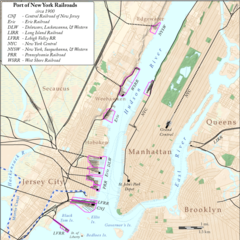Weehawken Terminal
|
Weehawken Terminal
|
|
|---|---|

Weehawken Terminal and yard, circa 1955
|
|
| Coordinates | 40°46′18″N 74°00′46″W / 40.771639°N 74.012750°WCoordinates: 40°46′18″N 74°00′46″W / 40.771639°N 74.012750°W |
| Operated by | New York Central Railroad (NYC) |
| Line(s) | West Shore Railroad |
| Tracks | 16 |
| Train operators | NYC, NYO&W |
| Connections |
|
| History | |
| Opened | 1884 |
| Closed | 1959 |
| Location | |
|
Location on a map showing the railroads in the Port of New York and New Jersey, ca 1900
|
|
Weehawken Terminal was the waterfront intermodal terminal on the North River (Hudson River) in Weehawken, New Jersey for the New York Central Railroad's West Shore Railroad division. It opened in 1884 and closed in 1959. The complex contained five ferry slips, sixteen passenger train tracks, car float facilities, and extensive yards. The facility was also used by the New York, Ontario and Western Railway. The terminal was one of five passenger railroad terminals that lined the Hudson Waterfront during the 19th and 20th centuries, with others located at Hoboken, Pavonia, Exchange Place and Communipaw.
A patent for a ferry route from Weehawken to Manhattan was first granted by Governor of New York Richard Coote in 1700. It was a sail and row service later superseded by steamboat service, notably at Hoboken in 1834. The route then operated sporadically for years, and became object of a legislative investigation in 1870. It was purchased by the New Jersey Midland Railway in 1871. From 1913 until the 1927 opening of the Holland Tunnel, it was a component of the Lincoln Highway, the first transcontinental highway in the United States, which began at Times Square, crossed the river, and travelled up Hudson Palisades along Pershing Road. In addition to 42nd Street, boats also travelled to Cortland Street. The Weehawken was the last ferry to the West Shore Terminal on March 25, 1959 at 1:10 am, ending 259 years of continuous ferry service.
...
Wikipedia

